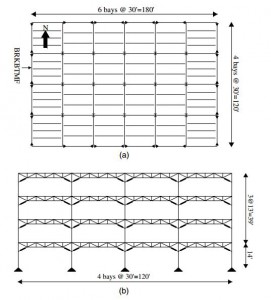Buckling restrained knee braced truss moment frame (BRKBTMF) is a novel steel structural system which combines steel trusses with buckling restrained braces (BRBs) to form an alternative seismic force resisting system. The combination of the steel trusses and the BRBs allows the BRKBTMF to have large interior opening without the need to provide ductile detailing for the steel trusses. This makes the design very efficient and economical. More importantly, through the use of BRBs as the designated energy dissipation devices, the damage is controlled within the BRBs, which can be replaced easily after the earthquake. This will drastically reduce the structural damage, repair cost and repair time which makes this structure more efficient and resilient towards future earthquakes.

Figure 1: Plan and elevation view of BRKBTMF
BRB Angle Study:
In this study, a modification of the performance-based plastic design (PBPD) procedure was derived to design the member sizes of the BRKBTMF. Parameter study was conducted, by varying the inclination of BRBs, to optimize the initial construction cost and expected financial loss during the maximum credible earthquake shaking. A prototype 4-story office building located in Berkeley, California, Unite States, was selected for this study. State-of-the-art site-specific hazard analysis, finite element models, damaged fragility models were used to evaluate the seismic performance of the BRKBTMF with different BRB inclinations. The result shows excellent seismic performance in the proposed BRKBTMF, where the structure is able to satisfy both the drift and force limits. The parameter study shows the design forces in the steel trusses are not affected by the inclination of the BRB. On the other hand, the design forces in the BRBs and columns increase as the inclination of the BRB becomes more horizontal. This results to larger column sizes, hence higher initial construction costs. The cost of the BRB is not significantly affected by the inclination of the BRB. This is because as the BRB inclination becomes more horizontal, the cross sectional area of the BRB increases, but the length of the BRB decreases. The results of the nonlinear dynamic analysis show the peak dynamic responses (peak inter-story drift and floor acceleration) of the BRKBTMF is very similar among the different BRB inclinations. This shows the proposed PBPD design methodology is very effective in designing the BRKBTMF. The detailed parameter study also shows that the BRB strain is the lowest when the BRB inclination is around 30 or 90 degree. As the BRB inclination gets closer to 60 degree (using the geometry presented in this study), at the same inter-story drift demand, the axial strain demand in the BRB is the highest. This results to high degree of damage to the BRBs, which translates to the highest degree of structural damages and financial losses during the maximum credible earthquake shaking. Hence, it is recommended that optimal choices of BRB inclination are either horizontal or connecting directly to the end of the columns.
Keywords: Performance-based design; plastic design; innovative system; structural optimization; buckling restrained brace
Figure 2: Variation of the BRB inclination
